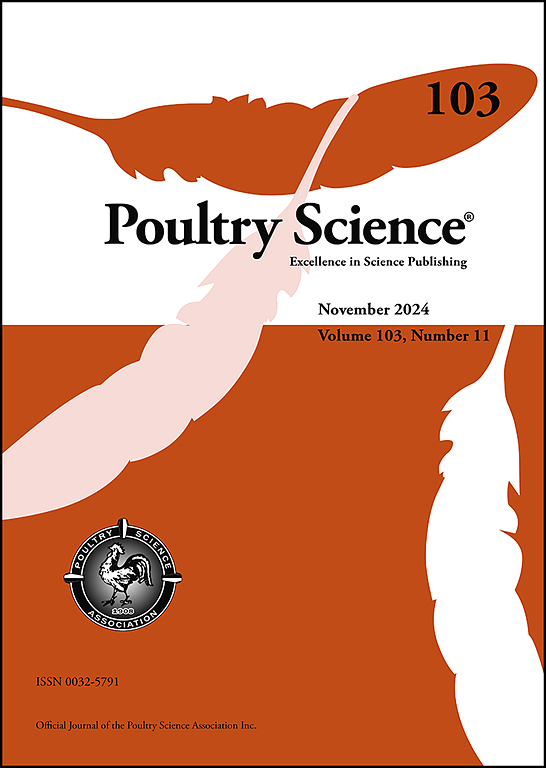Integrated transcriptomic and metabolomic analysis of goose epididymis reveals molecular markers associated with sperm mobility
IF 3.8
1区 农林科学
Q1 AGRICULTURE, DAIRY & ANIMAL SCIENCE
引用次数: 0
Abstract
The low fertility of geese has long constrained the development of the geese industry. Sperm quality plays a critical role in fertility, and sperm mobility (SM) serves as a key indicator of sperm quality. However, the molecular mechanisms underlying SM remain largely unexplored. The objective of this study was to identify molecular markers associated with SM in the epididymis of Zi geese (Anser cygnoides L.). The SM of 40 one-year-old ganders was assessed. Based on SM values, six ganders were selected: three with the highest SM (H group: n = 3, SM = 0.43 ± 0.02) and three with the lowest SM (L group: n = 3, SM = 0.10 ± 0.01, P < 0.001). Semen quality parameters, fertility, and hormone levels were measured in both groups. Epididymal tissues from the six ganders were subjected to transcriptomic and metabolomic analyses. Results identified 438 differentially expressed genes (DEGs) between the groups, primarily associated with transmembrane transport of proteins and ions. These DEGs were enriched in pathways such as “alanine, aspartate and glutamate metabolism,” “butanoate metabolism,” and the “PPAR signaling pathway.” Among these, ATP12A, ATP1B4, and CNDP1 were identified as key genes regulating SM. Additionally, 486 metabolites showed significant differences between the groups in both positive and negative ion modes. Integration of transcriptomic and metabolomic data revealed critical gene-metabolite pairs, including CNDP1–citric acid, implicated in SM regulation. Notably, the “arginine biosynthesis” pathway was significantly enriched by both DEGs and differential metabolites. In conclusion, this study provides novel insights into the molecular mechanisms regulating SM in the epididymis and lays a theoretical foundation for geese breeding programs.
鹅附睾的转录组学和代谢组学分析揭示了与精子活力相关的分子标记
鹅的低生育能力长期制约着鹅业的发展。精子质量在生育中起着至关重要的作用,而精子活动性(SM)是精子质量的重要指标。然而,SM的分子机制在很大程度上仍未被探索。本研究的目的是鉴定紫鹅附睾与SM相关的分子标记。对40只1岁大的公鹅进行了SM评估。根据SM值选取SM最高的3只雄性(H组:n = 3, SM = 0.43±0.02),SM最低的3只雄性(L组:n = 3, SM = 0.10±0.01,P <;0.001)。测量两组的精液质量参数、生育能力和激素水平。对6只雄鹅的附睾组织进行转录组学和代谢组学分析。结果发现了438个差异表达基因(DEGs),主要与蛋白质和离子的跨膜运输有关。这些deg在“丙氨酸、天冬氨酸和谷氨酸代谢”、“丁酸代谢”和“PPAR信号通路”等途径中富集。其中,ATP12A、ATP1B4和CNDP1被鉴定为SM的关键调控基因。此外,486种代谢物在正负离子模式下均表现出组间显著差异。转录组学和代谢组学数据的整合揭示了关键的基因-代谢物对,包括cndp1 -柠檬酸,与SM调控有关。值得注意的是,“精氨酸生物合成”途径被deg和差异代谢物显著富集。本研究为研究附睾SM的分子调控机制提供了新的思路,为鹅的育种规划奠定了理论基础。
本文章由计算机程序翻译,如有差异,请以英文原文为准。
求助全文
约1分钟内获得全文
求助全文
来源期刊

Poultry Science
农林科学-奶制品与动物科学
CiteScore
7.60
自引率
15.90%
发文量
0
审稿时长
94 days
期刊介绍:
First self-published in 1921, Poultry Science is an internationally renowned monthly journal, known as the authoritative source for a broad range of poultry information and high-caliber research. The journal plays a pivotal role in the dissemination of preeminent poultry-related knowledge across all disciplines. As of January 2020, Poultry Science will become an Open Access journal with no subscription charges, meaning authors who publish here can make their research immediately, permanently, and freely accessible worldwide while retaining copyright to their work. Papers submitted for publication after October 1, 2019 will be published as Open Access papers.
An international journal, Poultry Science publishes original papers, research notes, symposium papers, and reviews of basic science as applied to poultry. This authoritative source of poultry information is consistently ranked by ISI Impact Factor as one of the top 10 agriculture, dairy and animal science journals to deliver high-caliber research. Currently it is the highest-ranked (by Impact Factor and Eigenfactor) journal dedicated to publishing poultry research. Subject areas include breeding, genetics, education, production, management, environment, health, behavior, welfare, immunology, molecular biology, metabolism, nutrition, physiology, reproduction, processing, and products.
 求助内容:
求助内容: 应助结果提醒方式:
应助结果提醒方式:


